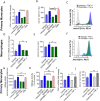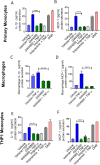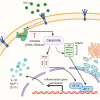Neutral sphingomyelinase 2 regulates inflammatory responses in monocytes/macrophages induced by TNF-α
- PMID: 33033337
- PMCID: PMC7544688
- DOI: 10.1038/s41598-020-73912-5
Neutral sphingomyelinase 2 regulates inflammatory responses in monocytes/macrophages induced by TNF-α
Abstract
Obesity is associated with elevated levels of TNF-α and proinflammatory CD11c monocytes/macrophages. TNF-α mediated dysregulation in the plasticity of monocytes/macrophages is concomitant with pathogenesis of several inflammatory diseases, including metabolic syndrome, but the underlying mechanisms are incompletely understood. Since neutral sphingomyelinase-2 (nSMase2: SMPD3) is a key enzyme for ceramide production involved in inflammation, we investigated whether nSMase2 contributed to the inflammatory changes in the monocytes/macrophages induced by TNF-α. In this study, we demonstrate that the disruption of nSMase activity in monocytes/macrophages either by chemical inhibitor GW4869 or small interfering RNA (siRNA) against SMPD3 results in defects in the TNF-α mediated expression of CD11c. Furthermore, blockage of nSMase in monocytes/macrophages inhibited the secretion of inflammatory mediators IL-1β and MCP-1. In contrast, inhibition of acid SMase (aSMase) activity did not attenuate CD11c expression or secretion of IL-1β and MCP-1. TNF-α-induced phosphorylation of JNK, p38 and NF-κB was also attenuated by the inhibition of nSMase2. Moreover, NF-kB/AP-1 activity was blocked by the inhibition of nSMase2. SMPD3 was elevated in PBMCs from obese individuals and positively corelated with TNF-α gene expression. These findings indicate that nSMase2 acts, at least in part, as a master switch in the TNF-α mediated inflammatory responses in monocytes/macrophages.
Conflict of interest statement
The authors declare no competing interests.
Figures






Similar articles
-
Acid sphingomyelinase-derived ceramide is not required for inflammatory cytokine signalling in murine macrophages.Cytokine. 1998 Sep;10(9):654-61. doi: 10.1006/cyto.1998.0344. Cytokine. 1998. PMID: 9770326
-
Early activation of nSMase2/ceramide pathway in astrocytes is involved in ischemia-associated neuronal damage via inflammation in rat hippocampi.J Neuroinflammation. 2013 Sep 3;10:109. doi: 10.1186/1742-2094-10-109. J Neuroinflammation. 2013. PMID: 24007266 Free PMC article.
-
TNF-α Induces a Pro-Inflammatory Phenotypic Shift in Monocytes through ACSL1: Relevance to Metabolic Inflammation.Cell Physiol Biochem. 2019;52(3):397-407. doi: 10.33594/000000028. Epub 2019 Mar 8. Cell Physiol Biochem. 2019. PMID: 30845379
-
Neutral sphingomyelinase-2 and cardiometabolic diseases.Obes Rev. 2021 Aug;22(8):e13248. doi: 10.1111/obr.13248. Epub 2021 Mar 18. Obes Rev. 2021. PMID: 33738905 Free PMC article. Review.
-
Role of neutral sphingomyelinases in aging and inflammation.Subcell Biochem. 2008;49:469-86. doi: 10.1007/978-1-4020-8831-5_18. Subcell Biochem. 2008. PMID: 18751923 Review.
Cited by
-
Protective Effects of COG133 on Carbon Tetrachloride-Induced Acute Liver Injury: Modulation of Inflammation, Apoptosis and Sphingolipid Metabolism.J Cell Mol Med. 2025 Jun;29(12):e70677. doi: 10.1111/jcmm.70677. J Cell Mol Med. 2025. PMID: 40542610 Free PMC article.
-
Ceramide kinase regulates TNF-α-induced immune responses in human monocytic cells.Sci Rep. 2021 Apr 15;11(1):8259. doi: 10.1038/s41598-021-87795-7. Sci Rep. 2021. PMID: 33859296 Free PMC article.
-
Abnormalities of Sphingolipids Metabolic Pathways in the Pathogenesis of Psoriasis.Metabolites. 2023 Feb 16;13(2):291. doi: 10.3390/metabo13020291. Metabolites. 2023. PMID: 36837912 Free PMC article. Review.
-
Ceramides as Mediators of Oxidative Stress and Inflammation in Cardiometabolic Disease.Int J Mol Sci. 2022 Feb 28;23(5):2719. doi: 10.3390/ijms23052719. Int J Mol Sci. 2022. PMID: 35269861 Free PMC article. Review.
-
IFN-γ and LPS Induce Synergistic Expression of CCL2 in Monocytic Cells via H3K27 Acetylation.J Inflamm Res. 2022 Jul 27;15:4291-4302. doi: 10.2147/JIR.S368352. eCollection 2022. J Inflamm Res. 2022. PMID: 35923906 Free PMC article.
References
Publication types
MeSH terms
Substances
Grants and funding
LinkOut - more resources
Full Text Sources
Research Materials
Miscellaneous

